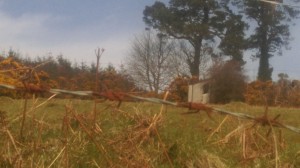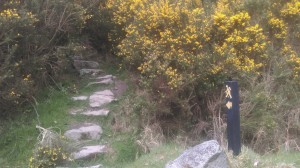These hills and glens this evening pour
Their tides of peace toward Ria’s door.
O may they for a lifetime shut
Their sunset wealth in Ria’s hut.
F.R. Higgins March 9, 1938
The complications of Ria Mooney’s relationship with Abbey Managing Director Fred Higgins are slowing unfolding. When the Minute Books of the Abbey Theatre were released some months ago, I discovered that Higgins had demanded a formal chastisement of Ria for allegedly “criticising the Board in public and making personal references to some of the Directors.” The accusation, which smacks of paranoia, is all the more nasty when you read the verse Higgins wrote for her in March 1938. She clearly had forgiven him by then. They had recently returned from a US tour, (where all kinds of illicit relationships had begun), but it was business as usual at the Abbey. As always, Ria had little money and worried constantly about it, but she found solace in a place where monetary wealth mattered little.
I’d come to think that Ria’s ‘hut’ was a mystical, imagined place. Lilian Roberts Finlay describes visiting a cottage in Annamoe, but we know she’s far from being reliable. Even more fantastical was the idea that Lilian and her friends could make it back to Dublin on public transport in an hour. But this week I met Niall Mooney, nephew of Ria. And I discovered that not only was the hut a real place, a family holiday home for generations, but it is still standing. Or is it?
Armed with directions, and Google maps, I set out for Wicklow. I took hair-raising bends in the car, climbed barbed wire fences, took paths set out by the Wicklow Way, waded through grass while checking regularly for cows. I came home convinced that I’d seen Ria’s hut. But was it that one? Or that one? Or that one?

In Dublin lore, four Dublin-born grandparents are required for Dublin heritage. I have one; I barely qualify. The Mooney family are true Dubs. Family research has shown they go back generations (they’ve managed six or seven) with n’er a culchie cousin to be found. “No.7” was their original home: a bakery/shop/house on Baggot Street, metres away from the Shelbourne Hotel.
On the 1911 Census, William Mooney is listed as a ‘confectioner’: bread and cakes were his speciality and he did the ‘outdoor catering’ for the Eucharistic Congress of 1932. The census shows Ria was the eldest of five children. Niall’s father was two years old when their mother passed away in 1917. She was 42. Niall’s wife Kathy met Ria only a handful of times at family occasions, but they share something: artistic training and an eye for colour and form. Kathy’s pottery and ceramics can be seen here. Niall and Kathy talked to me about Patrick Tuohy, a Dublin artist who taught Ria at Dublin’s Metropolitan College and subsequently moved to New York. Ria met up with him there, and, sadly, it was Ria who found him after he committed suicide.
Ria sat for some of Tuohy’s paintings (more of that next week) and when she was spending time at his studio in the early 1920s, so was one Fred Higgins, up-and-coming poet. Here is Tuohy’s portrait of him from 1922:
In 1936, Ria reported to the board that she had auditioned 120 for the Abbey School and had selected 28. With 14 already enrolled, she had a total of 42. She said the new students were “much better than any of the students who commenced last year. The majority of the new men pupils were very promising.”
In her New York walk-up apartment, vividly painted in blue and red, Ria frequently hosted parties for her young charges from the Civic Repertory Apprentice Company. She didn’t quite fit in to the social milieu of the Company, or she simply enjoyed the vibrant energy of the trainees. When she came back to Dublin, she hosted similar parties for the students from the school and the Experimental Theatre Company. She still lived at home with her father; she held her parties in Wicklow and Lilian went along.
But Lilian couldn’t have helped Ria white-wash her cottage (as her novel suggests); according to Niall, the hut was corrugated iron, two rooms with no running water and bunk beds. And it is indeed on a bus route to Dublin, if you’re prepared to walk (or cycle) a few miles. During the summer months, Niall’s father would rise early on a Monday and, with permission from the owners of Powerscourt Estate, walk across the Estate until he met the Enniskerry road and the first bus to Dublin.
For all her inaccuracies, we have only Lilian’s account of the Wicklow parties…
The students pack whatever food they can snaffle from home, usually bread, biscuits and milk. They set out in the afternoon, shaking off the dirt and noise of the city as they reach the outskirts. Their wild chatter softens as the roads narrow and twist and they descend into the stillness of the valley. Ria greets them warmly as they trudge up the hill; she has been waiting: smoking and reading in the shade of the doorway. In the hazy sunshine of the long evenings, they sit in the field outside the hut and discuss drama and poetry over their makeshift picnic, drinking warm milk from a bottle. Some sing, or recite poetry. If they are more reticent when Ria is accompanied by Fred Higgins, she encourages them by reciting verses herself. This is Synge country, and his words dance in the Wicklow air.
As darkness falls, Ria arranges charades with complicated play titles to act out. For all their passion and earnest devotion, these are relaxed evenings full with laughter. Higgins watches from the side of the circle, arms folded. The girls huddle into their cardigans as the sun sets and cold creeps up the hill. Ria brings out blankets from the hut: children’s blankets left by her nieces and nephews. They huddle and laugh and sing, until they have to stand, shake out their cramped limbs and head for home. Ria waves them off.
There is no darkness like the black quilt of Wicklow night. I can hear Ria go back up the hill, her footsteps through the grass lit only by her cigarette butt. No stars tonight and a moon wrapped in gauze. Lilian’s friend wheels a bike; it squeaks in the distance. Higgins is in a chair inside, his breathing heavy as he dozes. Ria moves around, her footsteps quiet and small but sure in this familiar place. She hums under her breath as she rummages for a candle and matches. An amber blaze catches the page hanging as she closes the latch on the corrugated iron door. She has hung up Higgins’ poem for all to see: their sunset wealth in Ria’s hut.





April 15, 2016 at 10:15 am
Beautifully imagined, Ciara – very cinematic. Loved it.
April 15, 2016 at 10:17 am
Thanks Finola, Your mother providing invaluable context again… and there’s more to come! x